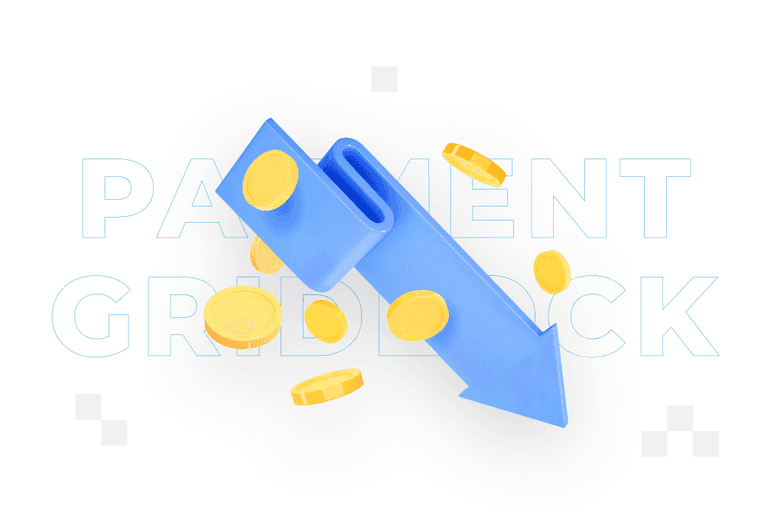
Payment gridlock – how does it arise and how to deal with it?

Payment gridlock is a financial problem for many businesses, leading to delays in the payment of receivables. Its consequences can affect a company’s liquidity and, in extreme cases, even its continued operation.
In this article you will learn:
- What is payment gridlock?
- Why does payment gridlock occur?
- What are the effects of payment gridlock?
- How to avoid and fight against payment gridlock?
Payment gridlock – definition
Payment gridlock is a situation in which a debtor is late in paying a debt owed to a creditor, despite having the financial means to do so. In other words, it is a deliberate delay of payment despite the possibility of making it. In many countries, including Poland, payment gridlock is a serious problem, especially in business-to-business (B2B) relations.
A prolonged payment gridlock can lead to liquidity problems for a company that is waiting for payment. If a company that has supplied goods or services does not receive payment on the agreed date, it may find it difficult to pay its own bills, pay employees’ salaries or reinvest in growth.
Payment gridlock is not just about a single relationship between one debtor and one creditor. Often businesses operate in complex networks of transactions with multiple suppliers and customers. When one company delays payment, this can have a knock-on effect on the entire transaction network. For example, company A delays payment to company B because of its own liquidity problems. As a result, company B may find it difficult to settle its own obligations to company C. If company C also does not receive payment on time, its ability to pay organisation D may be affected, and so on.
The domino effect caused by payment bottlenecks can lead to serious financial crises, especially in highly interconnected sectors or in situations where access to short-term financing is limited. Therefore, payment bottlenecks are not only a problem for individual companies, but can pose a threat to economic stability on a wider scale. In practice, this can mean that financial problems for one company can lead to problems for many others in the supply chain.
Payment gridlock is a situation in which a debtor delays payment of its obligations to a creditor.
Definition of payment congestion.
In order to prevent payment gridlock problems, many countries introduce legal regulations on payment terms. For example, in Poland, legislation seeks to limit unfair payment term practices, and companies can claim interest for late payment.
Reasons for payment bottlenecks
Payment congestion can lead to serious consequences for businesses, especially those with lower financial resilience, and arises for a variety of reasons. Here are some of the main reasons:
- The debtor’s lack of liquidity is the most obvious reason. If a business does not have sufficient funds to pay its bills, late payments will occur. This may be due to inadequate financial management, low revenue, unexpected expenses or a financial crisis.
- Poorly organised accounting processes, such as errors in invoicing or accounting systems, and a lack of proper communication between departments can lead to late payments.
- Some companies deliberately delay payments in order to benefit from additional ‘credit’ from suppliers or to improve their liquidity temporarily.
- If there are disagreements about the quality of the product or service delivered, its price or other invoice details, payment may be delayed until the dispute is resolved.
- Sometimes companies may not be aware of upcoming payment deadlines due to a lack of adequate monitoring tools or human error.
- When a sector or the economy as a whole is experiencing a crisis, many companies may find it difficult to pay on time.
- If a company has difficulty obtaining financing on favourable terms, it may delay payments to avoid costly loans.
- If the contractual terms of payment are unclear or not properly agreed, this can lead to misunderstandings and delays.
Consequences of payment congestion
Payment congestion leads to a number of serious consequences both for individual companies and for the economic environment as a whole. In the first case, especially for smaller or less financially resilient companies, payment congestion can lead to liquidity problems. Failure to receive payments means that a company may struggle to cover day-to-day expenses such as salaries, rent or operating costs. In extreme cases, this can lead a business to insolvency or bankruptcy.
When businesses experience liquidity problems, they may have to seek additional funding, which involves additional costs and risks. This also affects their ability to invest and expand their business, which can inhibit growth and innovation in the long term.
In turn, at a macroeconomic level, the prevalence of payment congestion can lead to lower confidence among businesses and consumers. If companies fear that they will not be paid on time, they may become more conservative in their operations, reducing spending and investment, which may affect economic growth rates. Also, the knock-on effect caused by payment bottlenecks can lead to cascading financial problems in many sectors, increasing the risk of economic crises. While payment congestion may appear to be a debtor and creditor problem, it has far-reaching consequences that can affect the stability of the entire economy.
Ways to avoid payment bottlenecks
Avoiding payment congestion is key to maintaining healthy liquidity and building trust in business relationships. It is important to be aware of the risks of payment congestion and take deliberate steps to minimise them. Here are some ways that can minimise the risk of delays:
Understandable and clear contract terms
Before companies enter into any transaction, both parties should carefully establish but, above all, understand the payment terms. Precisely defining payment terms prevents later misunderstandings and potential delays. It is also worth establishing the consequences of failing to meet the deadlines – these may include, for example, interest charged for late payment.
Checking payment reliability
Before deciding to work with a new business partner, it is important to investigate their payment history. This allows you to assess the potential partner’s financial credibility and predict whether they will pay their obligations on time. There are many companies and tools on the market that make it possible to analyse creditworthiness in detail and to trace the past payment history of a given company.
Automation of accounting processes
Nowadays, it is possible to automatically monitor payment deadlines. This allows companies to keep track of upcoming deadlines (e.g. due dates for contributions) in real time and manage their receivables efficiently. Systems often offer functions for sending automatic reminders to counterparties, which increases the chances of timely payment of obligations. In addition, the ability to automatically generate and send invoices, e.g. through the use of an invoicing programme, significantly streamlines administrative processes and allows for faster settlement of transactions.
Communication with counterparties
Regular communication with debtors, especially when payment deadlines are approaching, prevents misunderstandings and unnecessary delays in settlements. Early dialogue and a proactive approach to communication not only strengthens business relationships, but also allows potential payment problems to be detected and resolved early.
Flexible payment terms
Offering flexible payment terms can attract and retain customers, especially those who may have temporary financial difficulties. By giving the option of paying debts in instalments or offering a variety of payment methods, businesses can adapt to individual customers’ needs. This approach builds trust, reduces the risk of late payment and often motivates customers to settle their debts more quickly.
Receivables insurance
Counterparty insolvency insurance provides a safety net for businesses that want to minimise the financial risks associated with unpaid debts. They act as compensation for unpaid receivables. When a counterparty becomes insolvent or, for some other reason, fails to settle its debt, the insurer pays compensation to the company to cover all or part of the outstanding debt, thereby protecting the company’s finances from unforeseen losses.
Early payment discounts
The use of early payment discounts is a practice that can effectively motivate customers to pay their obligations more quickly. For businesses, it is a strategy that not only improves liquidity, but also builds positive relationships with counterparties. When a customer makes payment before the agreed date and takes advantage of the discount offered, both parties benefit – the customer saves money and the company has funds in its account faster.
Implementing a debt collection policy
Introducing clear and consistent debt recovery procedures into the business is key to managing receivables. When counterparties are aware of such procedures and the consequences of not following them, there is a greater chance that they will want to avoid potential problems. Consistently applying procedures and communicating them to customers can act as a preventative measure, reducing the risk of late payment and increasing payment discipline among counterparties.
Factoring
Factoring involves the sale of unpaid invoices (receivables) by a company (known as the assignor) to a factoring company in exchange for immediate payment. The amount paid by the factoring company is usually less than the value of the invoice, as it is reduced by the factoring company’s commission. They often offer services related to the management of receivables, such as monitoring payments, reminding of upcoming deadlines or conducting collection processes. With this practice, a company can access cash almost immediately after issuing an invoice, without waiting for the counterparty to pay it. In many forms of factoring, it is the factoring company that assumes the risk of the counterparty’s insolvency, so in the event of non-payment by the counterparty, it is the company that is responsible for recovering the receivables.
Split payment
The split payment mechanism was introduced in some countries, including Poland, as a tool to combat VAT fraud. It involves splitting the payment for goods or services into two parts: net and VAT. The net amount is transferred to the seller, while the amount corresponding to VAT goes to a special, closed bank account of the seller, from which it can only be used for VAT-related settlements.
Thanks to this mechanism, the buyer is not physically able to keep the amount corresponding to VAT, which may lead to better payment discipline and fewer attempts to use this amount to improve his own liquidity. As the funds in the VAT account are exclusively for tax purposes, the seller is assured that the amount will not be used in other ways by the purchaser. On the other hand, however, this may reduce the liquidity of businesses that cannot freely dispose of the funds accumulated in the VAT account.
FAQ
Contact form
Develop your brand
Rate content:
You may be interested in:




